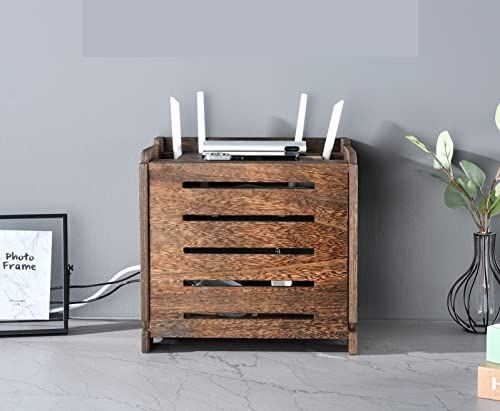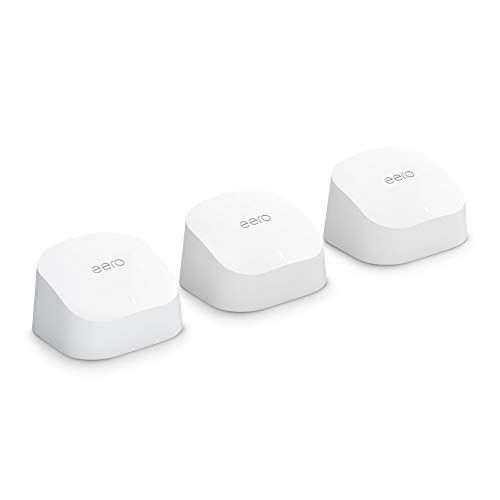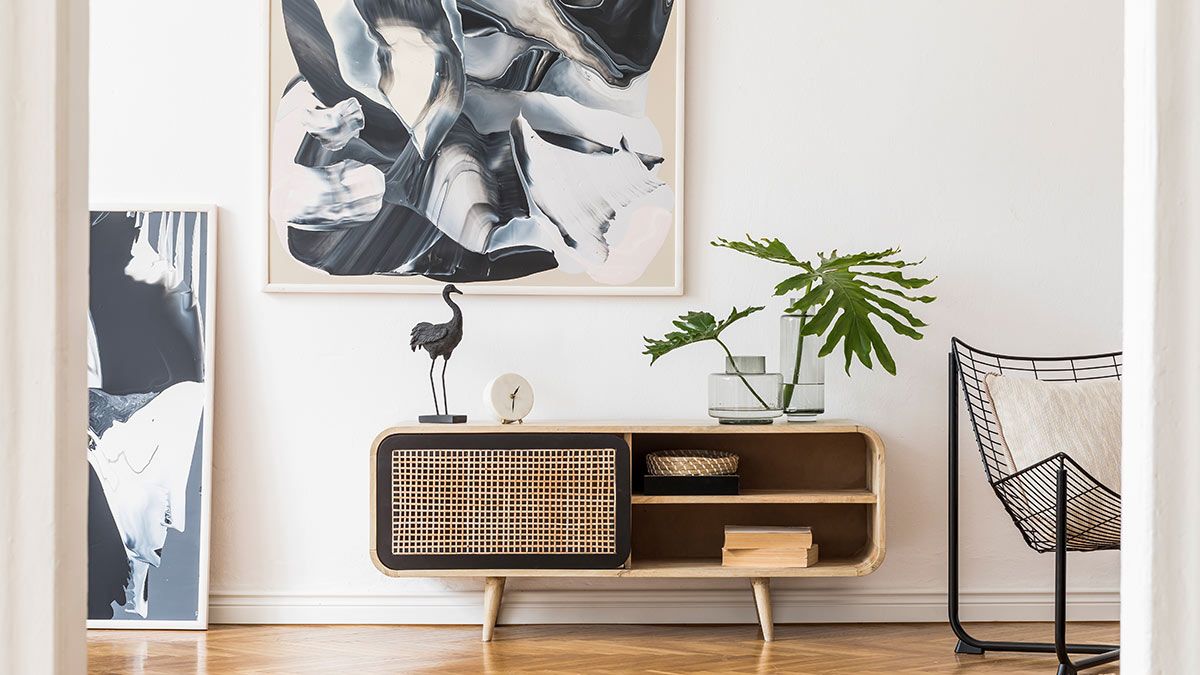Quick Links
Wi-Fi routers and related equipment aren't often the most lovely to look at---so you might be tempted to conceal them away. Is it OK to cover your router to hide it?
What Are Router Covers?
If you poke around the internet, especially in the craftier corners like Pinterest or YouTube craft channels, you'll come across all sorts of tutorials to help you conceal your unsightly network gear away---there are so many different ways to turn a black box with some antennas sticking out into something a little more homey looking.
The solutions range from terrible, such as making a box out of decorative metal sheeting to the not-as-terrible such as hiding your router in a lightweight cloth basket. There are even commercial options on the market like this wooden box, designed expressly for the task of camouflaging your router.

Bearut Wooden Router Box
This router cover offers plenty of ventilation, space for antennas, and even wall mounting options.
Hit up Etsy for router covers and you'll find all manner of them ranging from faux-book hideaways to airy mesh boxes. Before you buy a router cover, however, we encourage you to read through to the end of this article to ensure you find a solution that is optimal for both your decor and your Wi-Fi setup.
We Recommend You Don't Cover Your Router
As cute as a lot of these solutions are, our first and foremost recommendation is that you don't cover your Wi-Fi router, Wi-Fi access points, or other Wi-Fi gear. These devices are all designed to be in the open and not wrapped up, stuffed in things, or otherwise covered up. (If you really want to do it, however, keep reading as we'll address how to hide your router in an optimal way in the next section.)
Instead, before you consider stuffing your poor router inside some hollowed-out World Books you picked up at an estate sale, first consider doing what you can to smooth over your complaints about the device.
For example, if your primary complaint is that the LED lights are unbearably bright, then you're a perfect candidate to buy some Light Dims. We've been using them for years---they're a cleaner and more effective way to deal with bright LEDs than busting out the electrical tape.
And if your real complaint is how ugly and utilitarian your Wi-Fi gear looks, there's always the option to upgrade to a mesh system. Because mesh systems are intended to be placed throughout a home, the mesh nodes are designed to look way less industrial and way more decor-like.

Eero Dual Band Wi-Fi 6 Mesh System (3-Pack)
They're low profile, unobtrusive, and anything but a bulky black box bristling with antennas.
Google Nest Wi-Fi nodes look like gently curved little white canisters, for instance, and Eero nodes have a similar, albeit boxier, rounded look. Several of Netgear's mesh systems like the Nighthawk AX3600 MK83 have a shape like a texture cube that looks more like a little speaker than a Wi-Fi device.
Nearly all Wi-Fi mesh systems feature nodes without external antennas so whether you go with a cylinder, disc, or cube shape, the lack of large antennas sticking off the back goes a long way toward helping the nodes blend into your decor.
If, however, you really do want to cover up your Wi-Fi router or access points, we recommend reading over our tips and tricks below to ensure you get the decor effect you're going for without killing your router or Wi-Fi signal strength in the process.
If You Do Cover It, Follow These Rules
Let's say your Wi-Fi router is really ugly and you're not planning on upgrading your home network to get mesh nodes that look like an Art Deco interpretation of ocean waves, so that leaves concealing it in some fashion as a workaround.
If you're going to cover up your router, there's a right way and a wrong way to do it, so let's run through all the dos and don'ts of camouflaging your router.
Many of these tips build off of good router placement practices and understanding what things in your home block Wi-Fi signals, so check out our treatment of the topic here and keep the general concepts in mind as you plan where you will place your router and how you will camouflage it.
Don't Put It Inside Thick-Walled Containers or Packed Shelves
Wi-Fi signals are waves on the electromagnetic spectrum and a form of energy. Putting your router inside something with thick walls like a heavy decorative box just dampens the signal.
And it doesn't matter if the box is open on one side or even if the "container" is actually an opening on a bookshelf heavily loaded with books. All those books act as radio-wave absorbing barriers and significantly impede your signal. The more open-air exposure your router has, the better.
Don't Conceal It Inside, or Behind, Anything Metal
Just like putting your router inside a thick box or behind thick books is less than ideal, metal is a no-go when it comes to concealing your router. Among other materials in our list of things in the home that block Wi-Fi signals, metal is one of the most prevalent and problematic.
You don't want to hide your router in a metal mesh basket or container because that creates a Faraday cage effect that screws up your Wi-Fi coverage.
While some people purposely buy such "shields" for their Wi-Fi gear, you definitely don't want an accidental Faraday cage around a radio-based device. The goal is broader and faster Wi-Fi coverage, not less!
In addition to avoiding any sort of metal mesh, the same thing goes for metal bookshelves, metal boxes, or trying to hide a wall-mounted router behind a metal decoration like a tin sign or such. Even putting the router on the wall behind a large TV isn't wise, as most TVs have a massive metal shield inside.
Don't Cover the Router Body or Vents
Electronic devices generate heat and high temperatures are the enemy of all electronics. While the heat-dissipation demands of a small home router aren't anywhere near the demands of, say, a laptop or game console, that doesn't mean you can't pile stuff on top or shove the router in a cramped space without repercussions.
The excess heat might not outright kill the device, but you'll risk performance issues and instability. To avoid that don't tightly enclose the router in anything and especially don't put it somewhere that the heat vents on the router are covered up.
Whether your router is passively cooled---as most consumer routers on the market are---or it has a small fan, covering the vents up is a sure way to smother it.
This isn't to say you can never put the router inside or behind anything, but whatever you put it in should allow for heat to rise and have adequate air circulation.
Do Use Thin Coverings
The thinner and less metallic the thing you use to conceal your router the better. If the worst thing you could put your router in is a thick metal box with a lid, the best thing you could put your router in would be a large cloth cube---the cloth would hide the router but be effectively invisible in terms of Wi-Fi absorption.
If you want to put the router in a basket, opt for a basket with an open top and sidewalls made of material that is largely invisible to the Wi-Fi radio waves like cloth or woven grass material. This woven grass magazine organizer, for example, is large enough for most routers but allows for airflow.
Or, if you do want to want to conceal the router behind books build a shell of just the spines, sans all the paper, to ensure there's little between you and the Wi-Fi signal. This Pinterest tutorial shows how you can create the look without the bulk.
Whatever you conceal it with, you want that material to be non-metallic and as thing as possible.
Do Leave the Top Open
Speaking of airflow, leave the top open. As our internet use has become more demanding over the years, routers have become beefier and beefier to handle all of our streaming, gaming, and more. Beefier routers generate more heat than their little forebearers did.
Whatever you put the router in shouldn't have a lid. On top of not blocking the vents, you want somewhere for the heat to go and heat wants to go up.
Open-top baskets and bins, magazine racks either on a table or mounted on a wall, and other solutions help you to conceal the general shape and color of the router while still allow the heat to escape.
Do Leave the Antennas Sticking Out
If you hide the router inside something, try to select a container or location that allows you to position the router with the antenna sticking out.
In the case of routers with actual external antennas, this might mean positioning the router in a vertical position so the antenna can project up out of the basket or such you've placed the router in.
If you poke around you can find a wide variety of wooden router boxes, like this one we mentioned above that are designed to break up the profile of the router while still allowing the antennas to project out.
For routers with internal antennas, this may mean forgoing putting the router entirely inside something and instead place it on a side table or such where you can park something "lightweight" in front of it like a picture frame. It's not total concealment, but it helps with the "Yup, that's some black electronic box" profile most routers have.
Again, however, we want to emphasize that the best practice is always to just leave your Wi-Fi router and other Wi-Fi gear free in the open air.
Should you play around will concealing your router for aesthetic reasons and find that your Wi-Fi signal isn't what it used to be, it's worth either switching to a mesh system to get that low-profile decor vibe you want or ditching the covering and using your router "naked" again.

